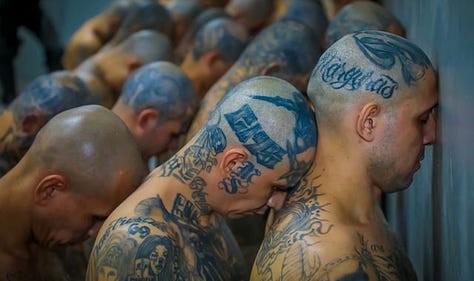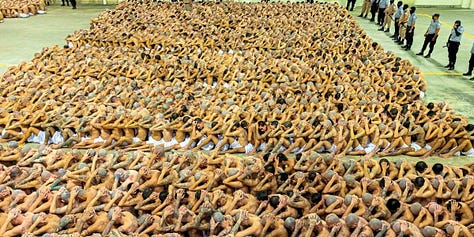Please look at the pictures of the tattooed inmates of El Salvador’s new 40,000-bed mega-prison, which according to its President will house them for “decades and decades.” But wait, don’t look at them yet. First decide to see the pictures without political opinion, reasoning, or judgment of any kind. Don’t worry, I’m not trying to depoliticize you. Just for a minute, suspend the mental machinery that produces outrage (or righteousness, or numbness).





I find that looking at such photos this way allows me to see into them more deeply. It also allows me to see more deeply into the circumstances that produced this little patch of hell to begin with.
An acquaintance, the photographer Martin Gray, sent me an article on the prison. Martin has spent a lot of time in El Salvador, which, he says, has become “consumed with fear and frustration and hopelessness.” One is tempted to see the prison as just another example of Third World despotism (tempted, anyway, until one remembers that it is the United States that boasts the world’s highest incarceration rate), but matters are not so simple. The exhausted populace, having lived in terror of violent criminal gangs for many years, strongly supports President Nayib Bukele’s anti-crime crackdown, which, if statistics are to be believed, has dropped El Salvador’s murder rate from a world-leading 103 per 100,000 in 2015 to less than 10 today. But effective does not mean just: it is not clear that all, or even most, of the tattooed men caught in this military-style roundup are guilty of any violent crime.
Basically, the government and people of El Salvador are in an impossible situation not of their own making. Therefore, to argue, as I see right and left doing, about whether this is a good policy is a diversion from the real originating issues. When Marin sent me the article, I responded,
Yeah, the debate about what to do with these gang members doesn't touch the real issue. The gangs are a symptom of the neoliberal stripping of wealth from places like El Salvador, primarily through the debt system, but also through transnational corporate influence on government abetted by the CIA and US State Department. Once all that is in place, every response to the gang problem is bad. Those poor men.
Martin took it a few steps further:
Poor men is right; inextricably caught in a multi-sided vise of pre-colonial tribalism, corrupt regional and local political parties (also gang affiliated), violent antagonisms between military and police forces, male machismo, grinding poverty, decades of thievery and illicit support by the ruling classes, the abject evils of CIA/USAID machinations, regional drug barons supplying ravenous markets in Europe and the states, gang members rendered subhuman by excessive amphetamine use, the strange nobility of dying a violent and painful death as catharsis promoted by centuries of rapacious Old World Catholicism, the inevitable complications brought by the social, political and economic effects of the (much hated) Chinese, and the millennia-long, myth-driven, pan-regional, pre-Columbian practice of blood sacrifice as a (completely useless) way of holding back the passage of astronomical time and its influence on the disappearance beneath the horizon of celestial objects believed to govern human existence. No way out of this morass. Not through the agencies of ancient, still worshiped Yucatec and Aztec death deities, the benevolent yet simultaneously angry Christ, the theologically confused Mormon missionaries, the naive social anthropologists churned out by Bible ‘colleges’ in empire Amerika nor the employees of the ineffective (well meaning?) NGO’s (unsuccessfully) competing for an ever-dwindling source of international aid (??) $. Bring on the ET’s, AI, cyborgs and T.Swift; maybe (repeat maybe) that’ll help. It’s beyond me.
Martin’s humor (at least I think it is humor, unless he knows more about Taylor Swift’s superpowers than I do) cloaks a more dilute version of the fear, frustration, and hopelessness he observed in the people of El Salvador. Virtually everyone I know has had such a moment, upon grasping the enormity and complexity of the world’s horrors, their interlocking nature, the inertia of institutions, and the power of the entrenched interests who administer them, when they throw up their hands and hope for a miracle, something external like ETs or Taylor Swift to deliver us from the hell we have made. To the conditioned rational mind it is hopeless.
Sometimes though, we are blessed with a glimpse of how powerful even one person can be to create change. Usually, some kind of naivete is required, some defiance of the limits our culture has taught our rational minds.
That is another reason I invited you to look at those photos with an unfiltered gaze. Rationally speaking, it is hard to know what to do. Petition El Salvador’s President? Plead with gangs to be nicer to each other? Write to the World Bank requesting a repeal of the international debt regime? OK, so what about irrationally speaking? Irrationally speaking, it isn’t so hard to know what to do. We can easily expand Martin’s litany to encompass the whole of the human condition. Not just one thing, not just some things, but everything is the cause of the mega-prison in El Salvador. And if everything is the cause, then the solution is everywhere too. There is something for each of us to do, at once naive and practical, to bring more life or beauty to the world.
Here is the test I offer myself. I imagine having a conversation with one of those men, on a soul-to-soul level. He asks me, “What were you doing while my youth, my dreams, my body, and my mind rotted away in prison?” I offer my answer. Can I look him in the eye without shame as I utter it? If I say, I was planting a garden, I was playing with a child, I was working to end hunger in Haiti, prisons in America, or war in Ukraine; if I say I was protecting a forest somewhere, I was healing a person or a patch of soil or my own trauma; even if I say I was with my mother in her dying days, he will nod his head, knowing that all of these are necessary to create a world in which no one occupies his condition anymore.
You can see, then, that I am not suggesting we retreat from political engagement into small, inconsequential acts of charity or kindness. The response to these photos might have something to do directly with the conditions they portray. More likely, if you really take them in, they will add to your fund of understanding and steady your commitment to love, justice, or healing in realms that, superficially, may have nothing to do with gangs and prisons in El Salvador.
To be sane in this world, it is necessary to carry both the horror and the beauty in one’s heart. Then you are playing with a full deck of cards. The full spectrum of the condition of life on earth will inform the heart in its choices. That is one of the keys to creating a more beautiful world in our lifetime. There is no reasonable plan of action that you or I could create to liberate and heal the men of El Salvador’s prison. There is, however, an unreasonable plan. I don’t know what it is. I don’t know how many years or centuries it will take (though that depends on us). All any of us can do is to learn to recognize our part. That recognition comes through taking in all the information, unfiltered by the usual mental programs. That is how to become available for miracles of healing and change. It isn’t as slow as we might think.
Paid subscribers also receive my other blog, “Letters from Charles Eisenstein” written in a more personal voice for a smaller, more intimate community.




I want to add an interesting twist to the story. An expert in digital media at the house where I'm staying right now highly doubts the authenticity of the photos. He thinks they were generated by AI. The photos originate with the El Salvador government. I am not sure what to think. The photography is quite amazing (regardless of its horrifying subject matter). If you wanted to stage such a scene even with enthusiastic volunteers, it would be no small feat, let alone with unruly prisoners.
"To be sane in this world, it is necessary to carry both the horror and the beauty in one’s heart."
That's the truest thing I've encountered so far today. Thank you, Charles.